Papers by Koundinya A V V
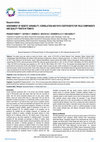
Introduction Tomato (Solanum lycopersicon Mill.) is the second most important vegetable crops of ... more Introduction Tomato (Solanum lycopersicon Mill.) is the second most important vegetable crops of Peru-Ecuador origin after potato. Ripe fresh fruits are consumed as salads, stew and various processed products such as juice, paste, powder, ketchup, sauce and canned whole fruits [1]. Unripe green fruits are used for preparation of pickles and chutney [1, 2]. Nutritionally, tomato is a good source of vitamin A and vitamin C [3] Fruits are also a good source of lycopene, ascorbic acid and ß-carotene, all of which are antioxidants and valued for their colour and flavour. For successful crop improvement programme, information on the nature and magnitude of genetic variability, degree of transmission of the traits is of immense importance [4]. The variability available in the population can be partitioned into heritable and non heritable component viz., phenotypic and genotypic coefficient of variation, heritability and genetic advance on which selection can be effectively carried out. The relative values of these types of coefficients give an idea about magnitude of variability present in the genetic population [5]. High phenotypic and genotypic co efficient of variation values indicates the presence of ample variation among the germplasm under study and felicitates the selection of desirable genotypes for improving the particular character [1]. However, presence of sufficient variation is not enough unless the character is additively inherent. Heritability and genetic advance are important selection parameters. High heritability alone is not enough for rewarding selection, unless accompanied by substantial amount of genetic advance [6]. High
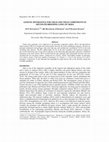
Fourty okra genotypes were subjected to the principle component analysis (PCA) and hierarchical c... more Fourty okra genotypes were subjected to the principle component analysis (PCA) and hierarchical cluster analysis (HCA) to estimate the existed genetic diversity for yield contributing characters. The first six principle components having Eigen value more than one and cumulatively contributing 74.93% to the total variability were selected. The PC1 added highly 26.72% to the total variability with significant loading of days to 50% flowering, days to first harvest and days to first flowering indicating these characters contributed maximum to the total variance. HCA revealed that the okra genotypes had considerable diversity and were classified into five divergent clusters. Among the five clusters, cluster 2 had highest number of genotypes (13) whereas cluster 5 had least number of genotypes (3). Clusters 1, 3 and 4 were having 10, 6 and 8 genotypes, respectively. It also indicated that geographical origin had no role in the diversity among the available germplasm.
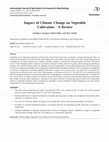
Vegetables are an important component of human diet as they are the only source of nutrients, vit... more Vegetables are an important component of human diet as they are the only source of nutrients, vitamins and minerals. They are also good remunerative to the farmer as they fetch higher price in the market. Likewise other crops, they are also being hit by the
consequences of climate change such as global warming, changes in seasonal and monsoon pattern and biotic and abiotic
factors. Under changing climatic situations crop failures, shortage of yields, reduction in quality and increasing pest and disease
problems are common and they render the vegetable cultivation unprofitable. As many physiological processes and enzymatic
activities are temperature dependent, they are going to be largely effected. Drought and salinity are the two important consequences of increase in temperature worsening vegetable cultivation. Increase in CO2 fertilization, but decreases after some extent. Anthropogenic air pollutants such as CO2 may increase crop yields due to increased CO2, CH and CFC’s are contributing to the
global warming and dioxides of nitrogen and sulphur are causing depletion of ozone layer and permitting the entry of harmful UV
rays. These affects of climate change also influence the pest and disease occurrences, host-pathogen interactions, distribution and ecology of insects, time of appearance, migration to new places and their overwintering capacity, there by becoming major setback to vegetable cultivation. Potato, among the all vegetables, is most vulnerable to climate change due to its exact climatic requirement for various physiological processes.
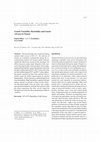
The present study was carried out during
autumn winter season of 2011-12. Six cultivars of
toma... more The present study was carried out during
autumn winter season of 2011-12. Six cultivars of
tomato are evaluated systematically during the research
period. Analysis
of variance studies indicates
significant
differences among all the genotypes for
all
the characters under study.
Majority of the characters
like plant height, fruits per plant, fruit weight,
equatorial
fruit diameter,
polar fruit diameter,
fruit yield
per
plant exhibit moderate PCV,
GCV
values and seeds
per
fruit exhibits higher GCV and PCV values indicating
greater variation for these traits and thus there is
greater
scope for further improvement by genetic
manipulation.
All
the characters exhibited high broad
sense
heritability.
High heritability coupled with high
genetic
advance as percent of mean for the characters
like plant height, fruits per plant, fruit weight,
equatorial
fruit diameter,
seeds per fruit and fruit yield
per
plant suggesting that they can be improved
through
direct selection due to predominant additive
variation.
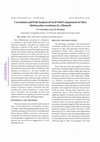
Okra [Abelmoschus esculentus (L.) Moench.] is a member of the family Malvaceae and is an importan... more Okra [Abelmoschus esculentus (L.) Moench.] is a member of the family Malvaceae and is an important vegetable crop grown in tropical and subtropical regions of the world. Correlation coefficient analysis measures the mutual relationship among various plant characters and determines the component characters on which selection can be based for improvement in yield. The magnitude and direction of association is measured by correlation coefficients. The estimation of correlation coefficients indicates only the extent and nature of association between yield and its components trails but does not show the direct and indirect effects of different yield attributes on yield per se. As more variables are considered in correlation, their indirect associations become more complicated, less obvious and somewhat perplexing. At this point, path coefficient analysis provides an effective means of dividing direct and indirect causes of association and also provides an opportunity of critical evaluation of specific cause acting to produce a given correlation and also measures the relative importance of each casual factor. Therefore, the knowledge of direct and indirect influence of components on yield is of prime importance to select high yielding genotypes.
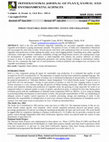
Seed is the first and foremost important commodity for successful vegetable cultivation. Indian
v... more Seed is the first and foremost important commodity for successful vegetable cultivation. Indian
vegetable seed industry is going enormously annually. The policies of Govt. of India since independence liberalized
and encouraged the seed trade in India. Several private seed firms with multinational base are actively involving in
vegetable seed production in India making the public sector much lagging behind. Expanding areas under vegetable
cultivation, varied agro-climatic conditions, availability of huge and cheap human resource are creating titanic scope
for development of vegetable seed industry in India.Vegetable seed industry has positive influence on Indian
economy in terms of income and employment generation and earning foreign exchange in international market.
There are few constraints like high cost of seed production, technical problems and stringent laws set break to the
vegetable seed industry in India.
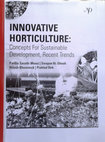
Innovative Horticulture
Grafting in vegetables is originated as a random experiment in Japan and Korea in the beginning o... more Grafting in vegetables is originated as a random experiment in Japan and Korea in the beginning of 20th century. It has gradually occupied prominent place in commercial vegetable production, especially in temperate world, when man has realized its potential in various dimensions viz., yield and quality improvement and stress resistance perhaps in the second half of the 20th century. By the end of 20th century to the beginning of 21st century it has started playing new role in induction of flowering and sex modification in vegetables. Grafting of a scion cultivar which is agronomically superior but lacking one or few characters onto a suitable rootstock facilitates the easy combining of characters. Grafting in vegetable crops eliminates the incompatible barriers in distant hybridization and long term screening and selection in development of cultivars with desirable traits. Moreover, it avoids use of chemicals in disease control. It is now popular among greenhouse growers and organic producers in producing quality vegetable seedlings. Albeit a variety of grafting methods are in vogue, introduction of grafting robots has made grafting easy in large scale production of grafted seedlings. The high cost involved in production of grafted seedlings can be compensated by high market value of the produce obtained through grafted seedlings. The grafting in vegetables has been confined mainly to fruit bearing vegetables like cucurbits, legumes and solanaceous vegetables and a little to tuber bearing crops like potato and sweet potato.
Books by Koundinya A V V
Snake gourd: Hand book of Cucurbits: Growth, Physiology and Cultural Practices



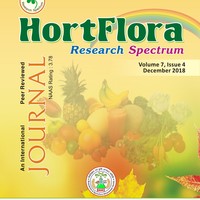
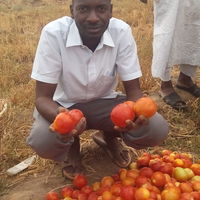






Uploads
Papers by Koundinya A V V
consequences of climate change such as global warming, changes in seasonal and monsoon pattern and biotic and abiotic
factors. Under changing climatic situations crop failures, shortage of yields, reduction in quality and increasing pest and disease
problems are common and they render the vegetable cultivation unprofitable. As many physiological processes and enzymatic
activities are temperature dependent, they are going to be largely effected. Drought and salinity are the two important consequences of increase in temperature worsening vegetable cultivation. Increase in CO2 fertilization, but decreases after some extent. Anthropogenic air pollutants such as CO2 may increase crop yields due to increased CO2, CH and CFC’s are contributing to the
global warming and dioxides of nitrogen and sulphur are causing depletion of ozone layer and permitting the entry of harmful UV
rays. These affects of climate change also influence the pest and disease occurrences, host-pathogen interactions, distribution and ecology of insects, time of appearance, migration to new places and their overwintering capacity, there by becoming major setback to vegetable cultivation. Potato, among the all vegetables, is most vulnerable to climate change due to its exact climatic requirement for various physiological processes.
autumn winter season of 2011-12. Six cultivars of
tomato are evaluated systematically during the research
period. Analysis
of variance studies indicates
significant
differences among all the genotypes for
all
the characters under study.
Majority of the characters
like plant height, fruits per plant, fruit weight,
equatorial
fruit diameter,
polar fruit diameter,
fruit yield
per
plant exhibit moderate PCV,
GCV
values and seeds
per
fruit exhibits higher GCV and PCV values indicating
greater variation for these traits and thus there is
greater
scope for further improvement by genetic
manipulation.
All
the characters exhibited high broad
sense
heritability.
High heritability coupled with high
genetic
advance as percent of mean for the characters
like plant height, fruits per plant, fruit weight,
equatorial
fruit diameter,
seeds per fruit and fruit yield
per
plant suggesting that they can be improved
through
direct selection due to predominant additive
variation.
vegetable seed industry is going enormously annually. The policies of Govt. of India since independence liberalized
and encouraged the seed trade in India. Several private seed firms with multinational base are actively involving in
vegetable seed production in India making the public sector much lagging behind. Expanding areas under vegetable
cultivation, varied agro-climatic conditions, availability of huge and cheap human resource are creating titanic scope
for development of vegetable seed industry in India.Vegetable seed industry has positive influence on Indian
economy in terms of income and employment generation and earning foreign exchange in international market.
There are few constraints like high cost of seed production, technical problems and stringent laws set break to the
vegetable seed industry in India.
Books by Koundinya A V V
consequences of climate change such as global warming, changes in seasonal and monsoon pattern and biotic and abiotic
factors. Under changing climatic situations crop failures, shortage of yields, reduction in quality and increasing pest and disease
problems are common and they render the vegetable cultivation unprofitable. As many physiological processes and enzymatic
activities are temperature dependent, they are going to be largely effected. Drought and salinity are the two important consequences of increase in temperature worsening vegetable cultivation. Increase in CO2 fertilization, but decreases after some extent. Anthropogenic air pollutants such as CO2 may increase crop yields due to increased CO2, CH and CFC’s are contributing to the
global warming and dioxides of nitrogen and sulphur are causing depletion of ozone layer and permitting the entry of harmful UV
rays. These affects of climate change also influence the pest and disease occurrences, host-pathogen interactions, distribution and ecology of insects, time of appearance, migration to new places and their overwintering capacity, there by becoming major setback to vegetable cultivation. Potato, among the all vegetables, is most vulnerable to climate change due to its exact climatic requirement for various physiological processes.
autumn winter season of 2011-12. Six cultivars of
tomato are evaluated systematically during the research
period. Analysis
of variance studies indicates
significant
differences among all the genotypes for
all
the characters under study.
Majority of the characters
like plant height, fruits per plant, fruit weight,
equatorial
fruit diameter,
polar fruit diameter,
fruit yield
per
plant exhibit moderate PCV,
GCV
values and seeds
per
fruit exhibits higher GCV and PCV values indicating
greater variation for these traits and thus there is
greater
scope for further improvement by genetic
manipulation.
All
the characters exhibited high broad
sense
heritability.
High heritability coupled with high
genetic
advance as percent of mean for the characters
like plant height, fruits per plant, fruit weight,
equatorial
fruit diameter,
seeds per fruit and fruit yield
per
plant suggesting that they can be improved
through
direct selection due to predominant additive
variation.
vegetable seed industry is going enormously annually. The policies of Govt. of India since independence liberalized
and encouraged the seed trade in India. Several private seed firms with multinational base are actively involving in
vegetable seed production in India making the public sector much lagging behind. Expanding areas under vegetable
cultivation, varied agro-climatic conditions, availability of huge and cheap human resource are creating titanic scope
for development of vegetable seed industry in India.Vegetable seed industry has positive influence on Indian
economy in terms of income and employment generation and earning foreign exchange in international market.
There are few constraints like high cost of seed production, technical problems and stringent laws set break to the
vegetable seed industry in India.